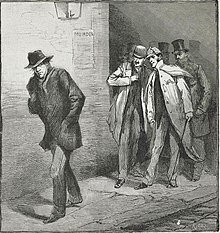Jack the Ripper | |
|---|---|
 "With the Vigilance Committee in the East End: A Suspicious Character" from The Illustrated London News, 13 October 1888 | |
| Born | Unknown |
| Other names |
|
| Motive | Unknown |
| Details | |
| Victims | Unknown (5 canonical) |
| Date | 1888–1891 (1888: 5 canonical) |
| Location(s) | Whitechapel and Spitalfields, London, England (5 canonical) |
Jack the Ripper was an unidentified serial killer who was active in and around the impoverished Whitechapel district of London, England, in 1888. In both criminal case files and the contemporaneous journalistic accounts, the killer was also called the Whitechapel Murderer and Leather Apron.
Attacks ascribed to Jack the Ripper typically involved women working as prostitutes who lived and worked in the slums of the East End of London. Their throats were cut prior to abdominal mutilations. The removal of internal organs from at least three of the victims led to speculation that their killer had some anatomical or surgical knowledge. Rumours that the murders were connected intensified in September and October 1888, and numerous letters were received by media outlets and Scotland Yard from individuals purporting to be the murderer.
The name "Jack the Ripper" originated in the "Dear Boss letter" written by an individual claiming to be the murderer, which was disseminated in the press. The letter is widely believed to have been a hoax and may have been written by journalists to heighten interest in the story and increase their newspapers' circulation. Another letter, the "From Hell letter", was received by George Lusk of the Whitechapel Vigilance Committee and came with half of a preserved human kidney, purportedly taken from one of the victims. The public came increasingly to believe in the existence of a single serial killer known as Jack the Ripper, mainly because of both the extraordinarily brutal nature of the murders and media coverage of the crimes.
Extensive newspaper coverage bestowed widespread and enduring international notoriety on the Ripper, and the legend solidified. A police investigation into a series of eleven brutal murders committed in Whitechapel and Spitalfields between 1888 and 1891 was unable to connect all the killings conclusively to the murders of 1888. Five victims—Mary Ann Nichols, Annie Chapman, Elizabeth Stride, Catherine Eddowes, and Mary Jane Kelly—are known as the "canonical five" and their murders between 31 August and 9 November 1888 are often considered the most likely to be linked. The murders were never solved, and the legends surrounding these crimes became a combination of historical research, folklore, and pseudohistory, capturing public imagination to the present day.